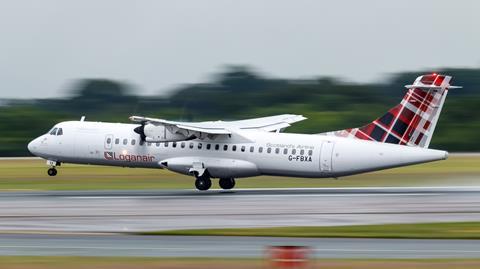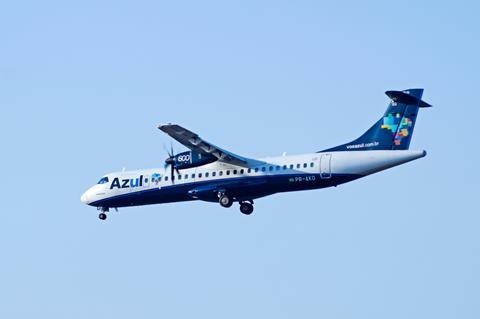ATR is marking four decades as the industry’s leading regional turboprop manufacturer this year. We find out from some of its customers why they remain loyal to the brand, and look at how the Franco-Italian company has become a pioneer in sustainable aviation
“We’re all in this together!” It’s a phrase stated by many a leader, but one that can ring hollow when times get tough. On the 40th anniversary of the creation of ATR, however, its parent companies and employees can look back and see that through all the ups and downs over that period, their achievements really did come from being in it together.

It has not all been plain sailing for the Toulouse-based airframer – jointly owned by Airbus and Italy’s Leonardo – with the years after 9/11 proving especially tough for ATR as for many other aerospace businesses. However, by the end of the first decade of the 21st century, orders were picking up strongly and ATR launched the -600 Series family featuring improved engines and a plethora of ‘under the skin’ advances.
Current chief executive Stefano Bortoli has had to face another tough period since Covid-19 struck in early 2020, but he retains the optimism of his predecessors. “ATR never stands still. The pandemic has deeply transformed our lives. However, it has also acted as a catalyst in the transition towards new innovative ways of connecting to our customers and stakeholders,” he says.
It is the OEM’s wide customer base that has been invaluable during downturns – and it continues to grow. Just two years ago, for example, Scotland’s Loganair took delivery of its first ATR and plans for its core turboprop fleet to be all-ATR within the near future.
The value the ATRs are bringing to Loganair is explained by chief executive Jonathan Hinkles. “We had a number of different drivers behind us to go into the ATRs. These were: Saab 2000 replacement; additional cargo capacity on the freight side of the business (because the first aircraft we took was actually a freighter); and a progressive replacement of Saab 340 aircraft throughout the Loganair network, which is what we’re now doing. So the ATRs have ticked a number of different boxes for us in terms of what they’re doing for us,” he remarks.
“We’re up to a fleet of nine now and expect that by mid-2023, when all the Saab 340s have gone, we’ll have a fleet of 24-25 ATRs, which will be a mix of 42s and 72s and a mix of passenger and freighter. We think all the freighters will be ATR 72s.
“On the passenger side though, the ATR 42 gives us a good level of versatility on some short runway missions,” Hinkles continues. “For example, we’re using that aircraft on Dundee to London City, where you have a short runway at both ends, and we’re using it in and out of Sumburgh [on the largest of the Shetland Islands where the airport serves as a base for transportation to oil rigs in the North Sea], where it has really taken over from the Saab.”
Hinkles reports that the ATRs are holding up well to the environmental rigours in which Loganair operates. The weather off the Scottish coast and around the islands can be treacherous, but he notes that the ATR is a sturdy aircraft and has been developed well for passengers.
“Passenger reaction to the ATR has been very positive. We took the step with all the ATR 42s coming into our fleet of putting in new seats and doing a full interior refurbishment before they joined us. The interior of the aircraft is the thing that shows its age the first to the customer. But the customer reaction to them – and that of the cabin crew – has been very good, with reduced noise compared with other turboprops and more space,” he says.
As an airline which serves remote communities, Loganair has put that space to good use. “On the ATR 42, we’ve slightly re-pitched one of the rows towards the back of the aircraft so that we can offer a row of ‘Red Cross’ seats that offer additional capability for people returning from hospital or requiring additional mobility. Those rows have about another four inches of pitch, which means that people with a full leg plaster or are coming back from a hip or knee replacement and would otherwise have to use an air ambulance, can actually take the scheduled flight,” states Hinkles.
Hinkles says the in-service performance of the aircraft and the flexibility they bring also offers a much greater level of commonality for the airline. “The ATRs also offer great flexibility with cargo on the scheduled network. Their hold capacity is significantly greater than either of the Saabs being replaced,” he adds.
“The ability to have ATR 42s and 72s, freighters and passengers, all with the same flight crew and engineering base, is unrivalled. There isn’t another aircraft that can give us that flexibility between big and little and passenger and freight all in one shipping order,” says Hinkles, who also notes that the aircraft are good friends to the environment.
“With the environmental aspect, fuel cost per seat and emissions per seat on an ATR 72-600 are less than half those on a Saab 2000, because the burn is lower and you have more seats over which to spread it,” he says.
“It will be really interesting to see where ATR takes the next stage of development, because even though the aircraft is at that point of being the best-in-class from an environmental point-of-view, being best-in-class doesn’t mean that you can stop there,” Hinkles says.
If there’s one country where the environment is always being observed closely, it is Brazil with, of course, its rainforests. A huge country with many remote communities, it benefits from the environmentally friendly ATRs on thin routes flown by Azul.

Almost from the start in 2008, ATRs were part of the strategy. Azul began its operations with Embraer E-Jets, but very soon, according to Carlos Naufel, vice-president technical, the demand created opportunities to go to different cities. “These were the ones that usually were not covered by the Brazilian network of the other carriers. We recognised that there are so many of these places where the airport could not handle a bigger aircraft,” he recalls. “We needed nothing bigger than the ATR to complement our network and it was a huge success.”
Naufel also notes that, although considered a low-fare airline, Azul has a different fleet strategy. “We are not a single-aircraft model, we have plenty of different aircraft types,” he states, before explaining why. “Our competitors here are LATAM and Gol. Today we fly to 130 cities – double the number they serve. They fly on the same routes in about 77% of cases, whereas we fly only about 11% of our routes to the same cities as them. We have about 850 flights a day. Our competitors have about 400-450 flights a day. But they don’t have ATRs or any similar aircraft, which is a differentiator for us. It means that we can connect a passenger from a remote city and fly them all the way to Fort Lauderdale on our network via São Paulo Campinas airport.”
Operationally, Azul has created a network of stations with maintenance facilities, which means having materials locally available. “It’s very challenging to put people around the country in several different stations and have all the materials and logistics to support that. But this is very important to the operation of the aircraft,” explains Jose Jacobi, Azul’s fleet programme coordinator. “It aids reliability, which is something we work on together with ATR, who are very supportive to make sure that this aircraft is available.”
Some of Azul’s ATRs also have a cargo quick-change capability. “They bring a lot of flexibility to our business and cover some very important cargo demands,” says Naufel.
“Cargo is very important for Azul,” Jacobi emphasises. “We had QC aircraft during the Covid period just doing cargo, with no passengers, which was a very important revenue generator for us during the pandemic. The cargo QC is a huge enabler – a true winner.”
On ATR fleet development, Naufel expects growth. “In comparison with people in other South America countries, Brazilians fly much less. That means the Brazilians can fly much more, so there’s room to add cities and therefore expand the ATR fleet.”
Sure enough, in line with Bortoli’s earlier comment, ATR is not standing still. In September 2021, the OEM signed a partnership agreement with Braathens Regional Airlines (BRA) and sustainable aviation fuel (SAF) producer Neste to accelerate the certification of ATR aircraft being able to fly with 100% SAF in their tanks.

The move follows a flight in 2019, dubbed the ‘Perfect Flight’, which used 50% SAF and the full avionics capabilities of an ATR aircraft. The outcome was a 46.6% reduction in emissions. “By making it possible to have 100% SAF in the tanks, the aim is to lower emissions by more than 80%,” says BRA’s chief executive Ulrika Matsgård.
The airline’s chairman, Per Braathens, emphasises BRA’s desire to use 50% SAF throughout the fleet in five years’ time, and 100% SAF in 10 years. “We will then be net-zero,” he states. “It’s important to understand that we really want to do this and use the best aircraft, with 40% more fuel efficiency than a jet. We want to investigate the high altitude effect so that we can demonstrate that it’s about saving the planet, not anything else.
“This is much more expensive than normal fuel and we as a company and the passengers of BRA have to pay for this. And if we don’t start now, we won’t be in time.”
At ATR itself, the company is also making an environmental contribution on the ground. “All the energy we use at HQ is generated from renewable sources. It costs us a little bit more but I decided to take that as personal and ATR’s contribution towards a better future,” Bortoli says.
The immediate future though, is about reaching that 100% SAF certification. “Nobody is missing from the table. Of course there is the aircraft, but that is, let’s say, a performing asset to the extent that it is well-used – so we need the airline. And to use the aircraft at its best, you need the other ingredient, which is the fuel from Neste. That has to be made in the right quantities at the right time at the right place at the right price.
“In this play, the important thing is that the three of us are in it together,” Bortoli emphasises. That has a familiar ring to it, but on this occasion it looks set to be fulfilled.













































